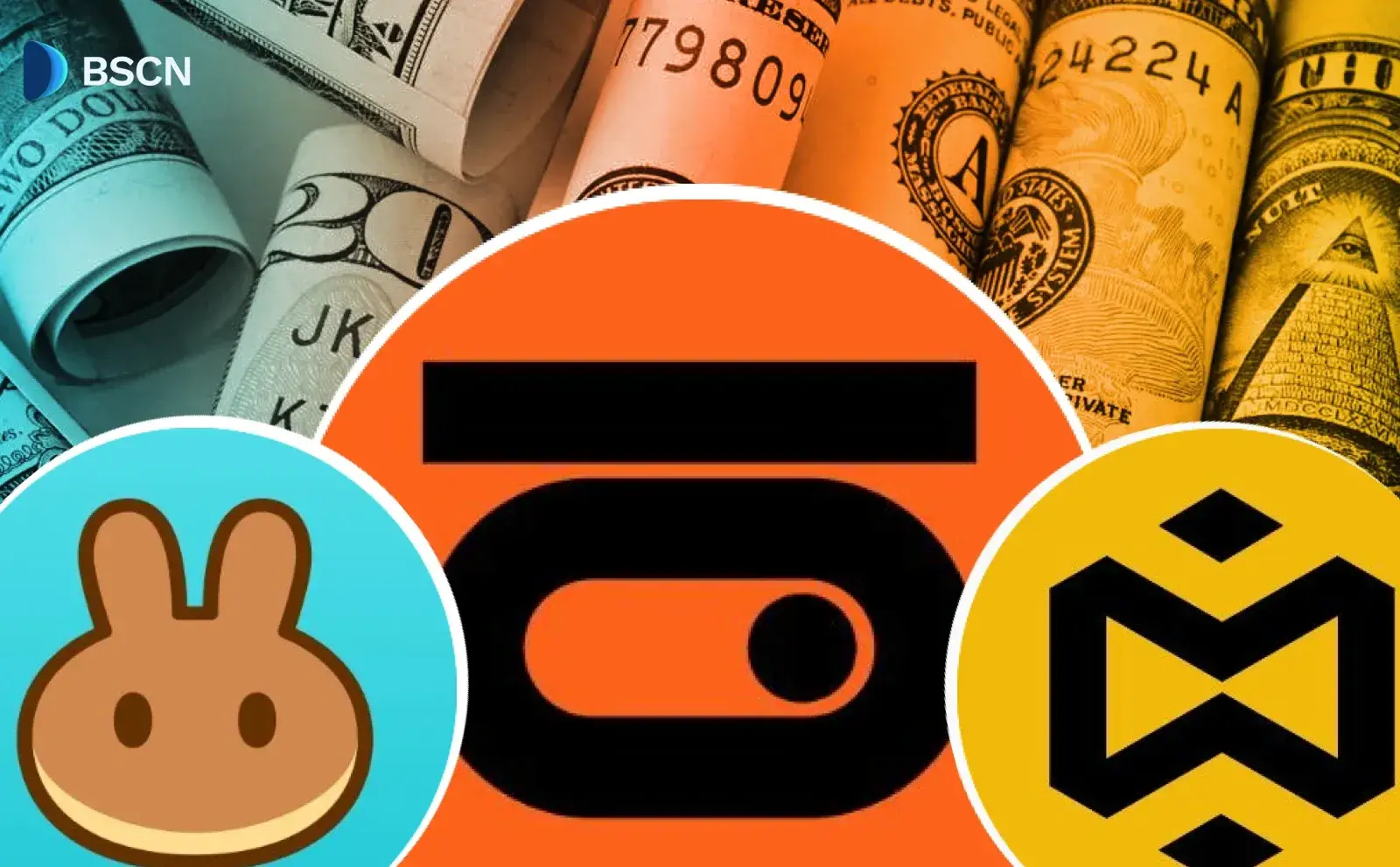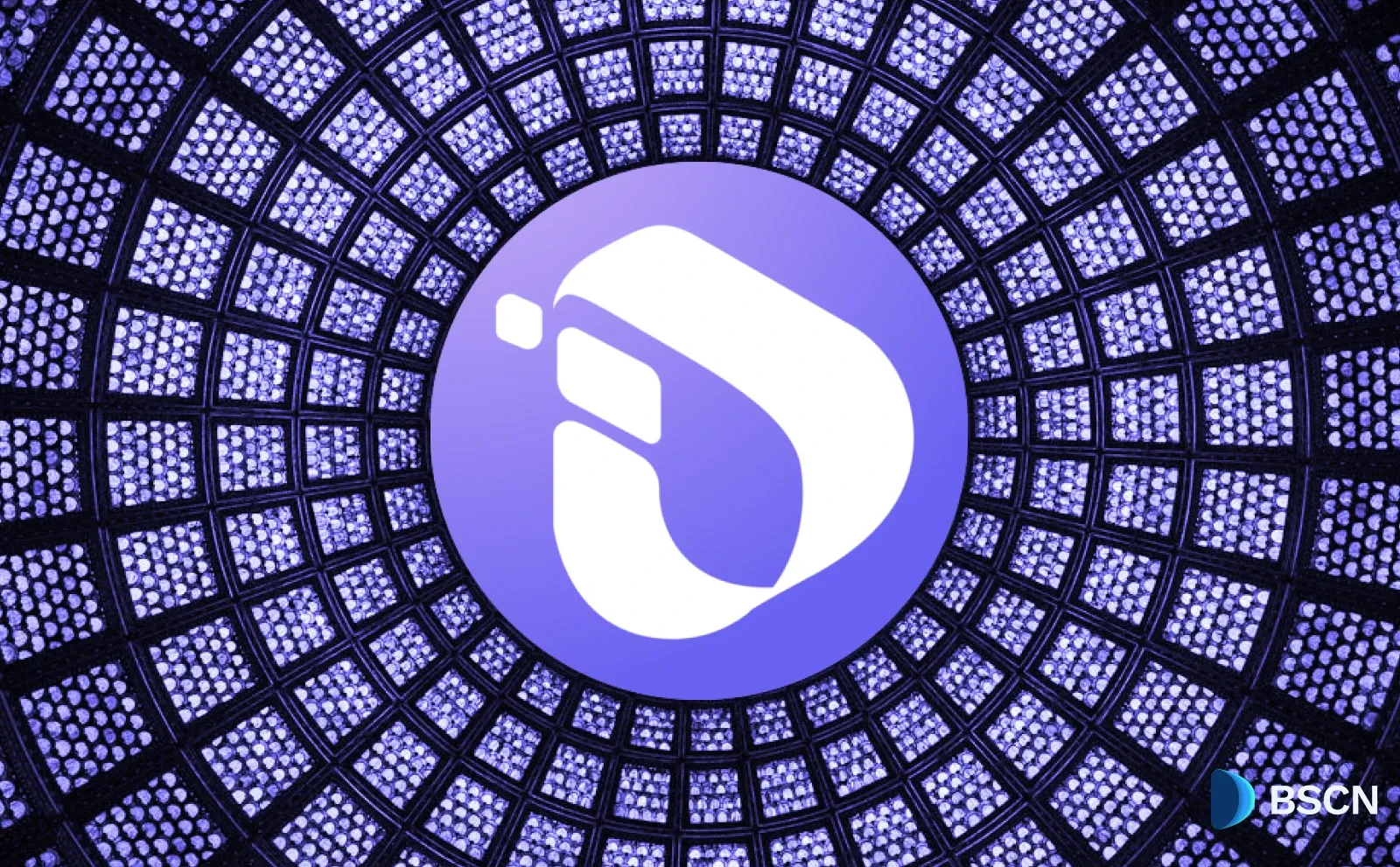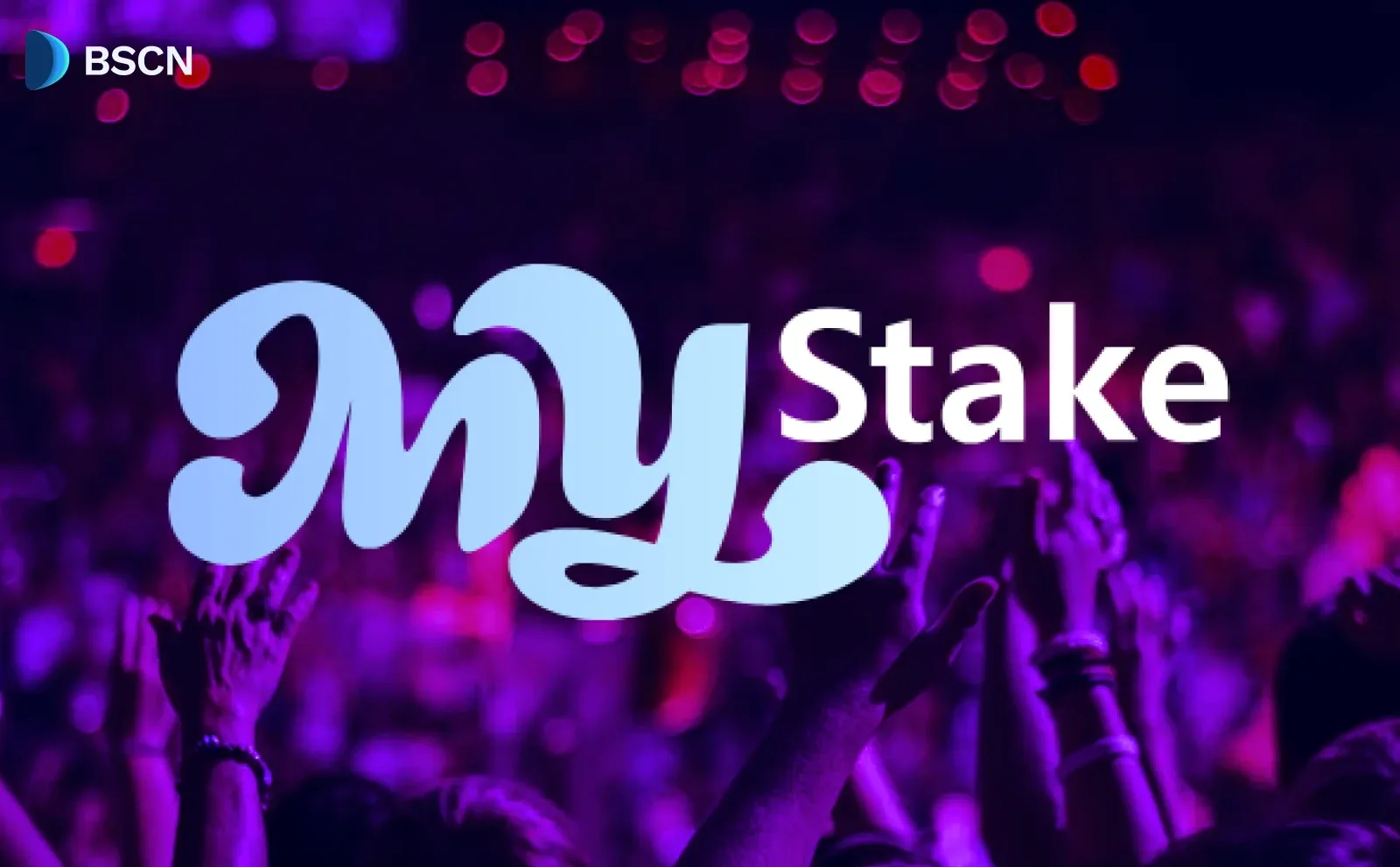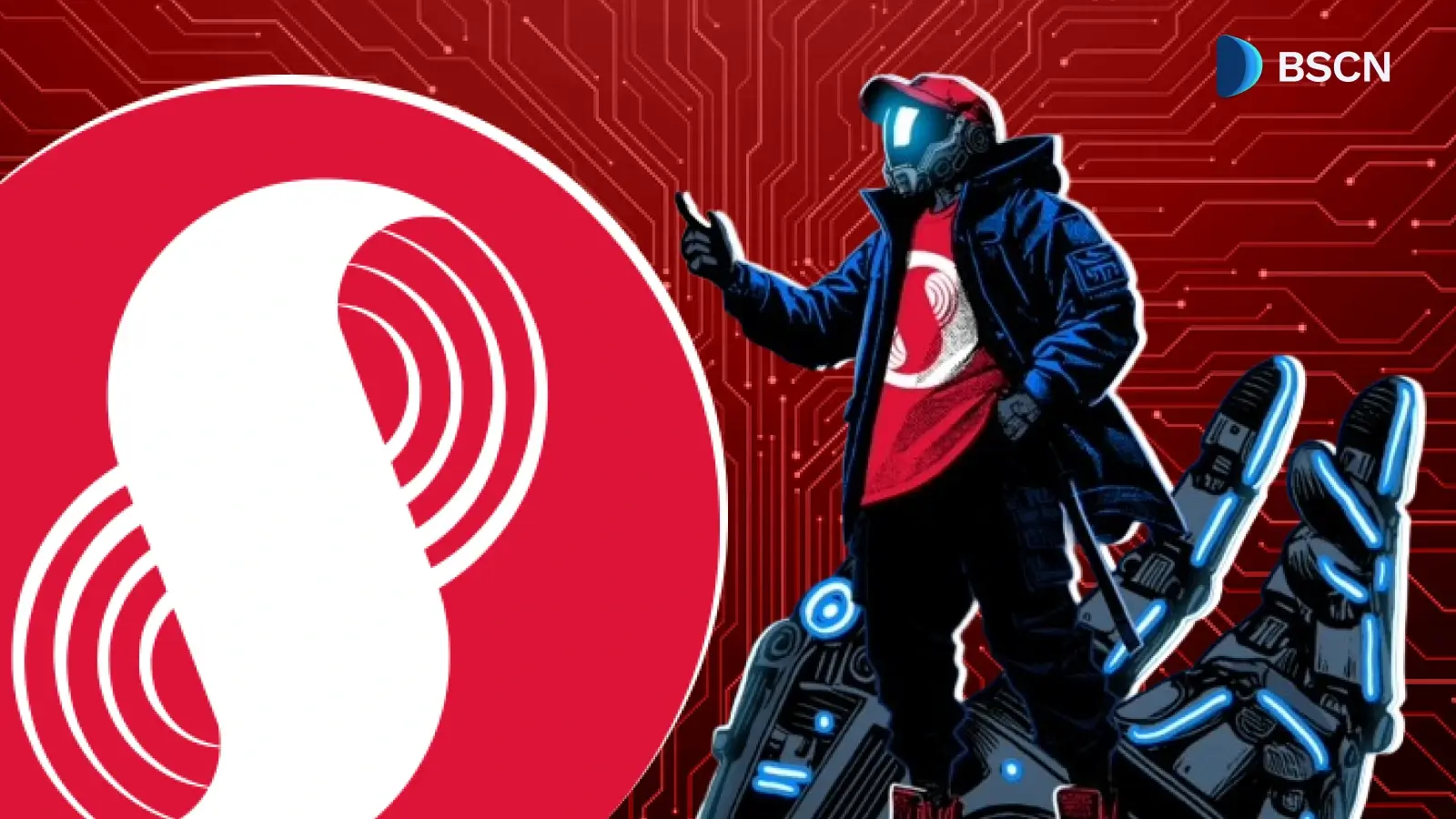Deepdive
(Advertisement)
What is OKZOO: The Decentralized Environmental Network Powered by AIoT Machines

OKZOO is a BNB Chain-based DePIN protocol for decentralized environmental data collection, gamified with virtual pets and $AIOT rewards.
UC Hope
August 21, 2025
(Advertisement)
Table of Contents
Operating exclusively on the BNB Chain, OKZOO is a protocol that has emerged as a notable player in the blockchain space by creating the world's first urban-scale and street-level decentralized environmental data network. Powered by AIoT machines, devices that blend artificial intelligence with the Internet of Things, OKZOO enables users to deploy portable hardware, such as the P-mini, to collect and share metrics on air quality, noise pollution, humidity, CO2 levels, temperature, volatile organic compounds, and more.
The platform fosters a community-driven ecosystem where data validation, storage, and application development occur through on-chain mechanisms, ensuring transparency and user ownership.
What sets OKZOO apart in The Blockchain Industry?
What sets OKZOO apart in the blockchain industry is its role in advancing Decentralized Physical Infrastructure Networks (DePIN), a sector that applies blockchain principles to real-world hardware and services, allowing decentralized ownership and operation of essential infrastructure.
Unlike traditional DePIN projects, which often struggle with user adoption due to technical barriers or a lack of everyday utility, OKZOO addresses these hurdles by integrating gamification and entertainment. Drawing from its origins in digital pet applications, the protocol ties virtual AI companions to physical data collection. These "pets" react to environmental conditions, evolving based on user interactions and real-world metrics, which encourages sustained participation without requiring expertise in cryptocurrency. This approach has built a user base exceeding 15 million across its ecosystem, demonstrating how blockchain can scale to mainstream audiences through intuitive, value-driven experiences.
OKZOO's importance extends to its innovative hardware strategy, a rarity in blockchain projects. By owning its manufacturing process, including factories for producing devices like the P-mini o1, the protocol ensures quality control, rapid scaling, and independence from third-party suppliers. This integration not only bolsters execution but also positions OKZOO as a potential supplier in the Web3 landscape, where hardware reliability is crucial for bridging the digital and physical worlds.
On the blockchain front, the protocol leverages token incentives via $AIOT to reward data contributions, staking, and validation, creating a self-sustaining economy that aligns user interests with network growth.
How OKZOO Started?
The OKZOO protocol started with digital pet applications before expanding into physical hardware. Its first version, OKZOO V1, launched earlier and drew about 5 million users through interactive AI companions. The second version, OKZOO V2, followed with around 700,000 users, focusing on testing market interest in these virtual pets. By early 2024, the project shifted toward integrating AIoT hardware, introducing devices like the P-mini to connect virtual elements with real-world environmental data collection.
This evolution addressed limitations in centralized environmental monitoring, including incomplete coverage from official sensors and a lack of data from indoor environments. Centralized systems often overlook hyperlocal details, such as urban heat islands or noise impacts in specific neighborhoods. OKZOO's approach utilizes a decentralized Internet of Things (DeIoT) combined with AI, enabling users to contribute data from handheld devices. The protocol incentivizes participation with peer-to-peer rewards, tokenized on-chain, which helps scale the network without heavy capital investment.
Recent updates by the platform discuss network effects, device capabilities, and ecosystem development. The project has also integrated with tools like the Binance Wallet to simplify user access.
Core Features of OKZOO
OKZOO includes several technical components that support its data network and user engagement:
Decentralized AIoT Devices: OKZOO relies on decentralized AIoT devices, such as the P-mini, which are portable hardware units equipped with microsensors to monitor environmental factors, including temperature, volatile organic compounds, sound levels, and CO2. These devices integrate interactive AI virtual pets that react to real-world conditions, providing an engagement mechanism that overlays entertainment on top of data collection processes.
Data Validation Mechanism: Data validation in OKZOO occurs through community-operated nodes, where participants stake tokens to verify the accuracy of submitted information before it is stored on-chain. This method promotes transparency and minimizes dependence on centralized entities, enabling validated data to be integrated into various AI applications.
RESTful APIs and Developer Tools: The protocol offers RESTful APIs alongside developer libraries that facilitate real-time inference and model training for AI applications built on the collected data. These tools include features such as transfer learning, which enables models to adapt knowledge across domains, and cross-chain compatibility, supporting integrations with other blockchain networks.
Incentive System with $AIOT Tokens: Users receive $AIOT tokens as rewards for tasks such as device deployment, data sharing, entry validation, staking as validators, and interacting with virtual pets. This system forms a feedback loop that boosts participation, thereby improving overall data precision and the network's operational efficiency.
Security and Performance Features: Security is maintained through token-based authentication and rate limiting to curb potential misuse, while edge computing performs data processing directly on devices to achieve reduced latency. Additionally, device energy management optimizes power usage to support extended operational periods without frequent recharging.
Gamification Components: Gamification is embedded through elements like pet evolution, which relies on care metrics such as happiness and health, thereby motivating ongoing user engagement. Virtual pets progress through five distinct stages, from Protoform to Prime, calculated using an experience point formula of 45 multiplied by the previous level raised to the power of 1.185.
Practical Applications and Impact: Collectively, these technical components enable OKZOO to fill monitoring gaps in areas with limited official infrastructure, including regions such as Sub-Saharan Africa, and deliver actionable insights, such as indoor ventilation alerts based on air quality data.
The OKZOO Ecosystem
The ecosystem comprises interconnected components, including hardware, data networks, tokens, and software tools, all of which are documented in the project's primer and specific guides.
Environmental Data Network
At its core is the environmental data network, which utilizes devices like the OK-mini to gather hyperlocal metrics both indoors and outdoors. Sensors detect air quality, wildfire smoke, noise, light, and other environmental factors. This network fills voids in traditional systems; for instance, during the 2023 Canadian wildfires, sparse sensors left gaps in coverage. People spend about 90% of their time indoors, yet indoor air often goes unmonitored. The network serves as a bridge for smart homes, offering recommendations and tokenizing data for user control. It complements government monitoring rather than replacing it.
AIoT Infrastructure
The AIoT infrastructure provides the technical foundation for applications. It features a custom API with RESTful endpoints, secure authentication, and dynamic rate limiting. AI connectors offer modular libraries in various programming languages, complete with sandbox testing environments. Inference and training pipelines support continuous learning through feedback loops.
Global data crawlers extract information from sources such as X and Google, processing it through uploaders, normalizers, and ingestors. Transfer learning techniques, including knowledge distillation and domain adaptation, enable models to enhance their efficiency. The infrastructure supports personalized experiences, such as predictive alerts or route planning, and integrates with pre-trained models from providers like Meta and OpenAI. It ensures compatibility across multiple blockchains and optimizes for low latency.
P-mini o1 Device
The P-mini o1 is a pocket-sized device running the Physical Mini Operating System 1. It includes microsensors for environmental tracking and interactive elements like touch and motion sensors for engaging with virtual pets. The AI learns user preferences over time, adapting its behavior.
Features include a companion camera for real-world responses, Portal Mode for immersive interactions, Social Projection for engaging with pets through nearby devices, and Ambient Presence for low-power monitoring. The device has a durable aluminum-polymer shell, magnetic charging, and energy optimization.
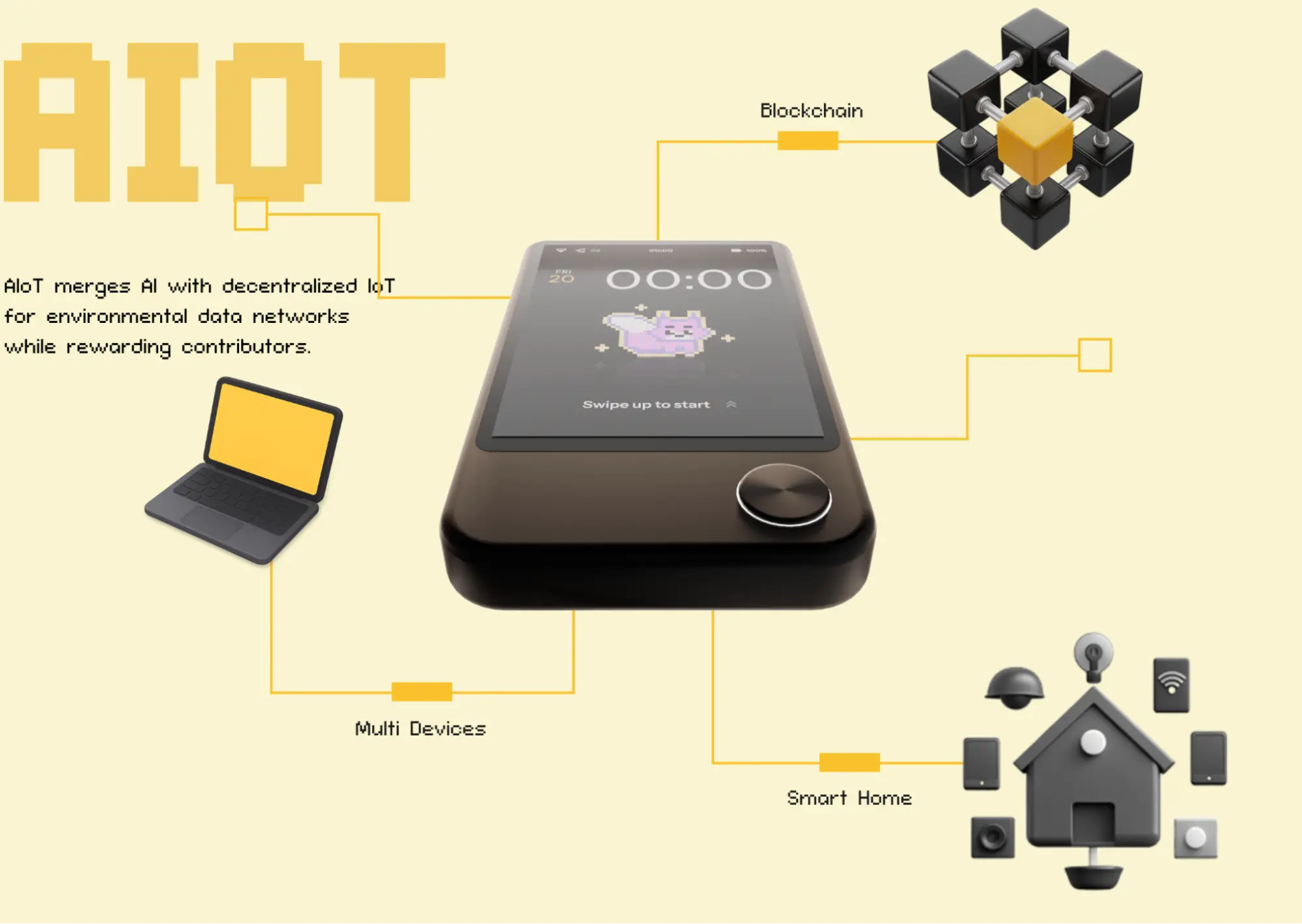
It syncs data to user accounts, contributing to the broader ecosystem. Design details, such as shell testing for sensor accuracy and data pipelines from raw signals to on-chain transmission, have been shared in recent X posts.
$AIOT Token and Tokenomics
The $AIOT token serves as the utility token for the protocol, with a total supply of 1 billion and an initial circulating supply of 8%. Users earn tokens through data sharing, staking, validation, pet care, and API access.
Token Allocations:
- 29% allocated to ecosystem growth
- 25% allocated to seed rounds
- 20% allocated to game rewards
- 12.5% allocated to the team
- 13.5% allocated to reserves, liquidity, initial DEX offerings, and more
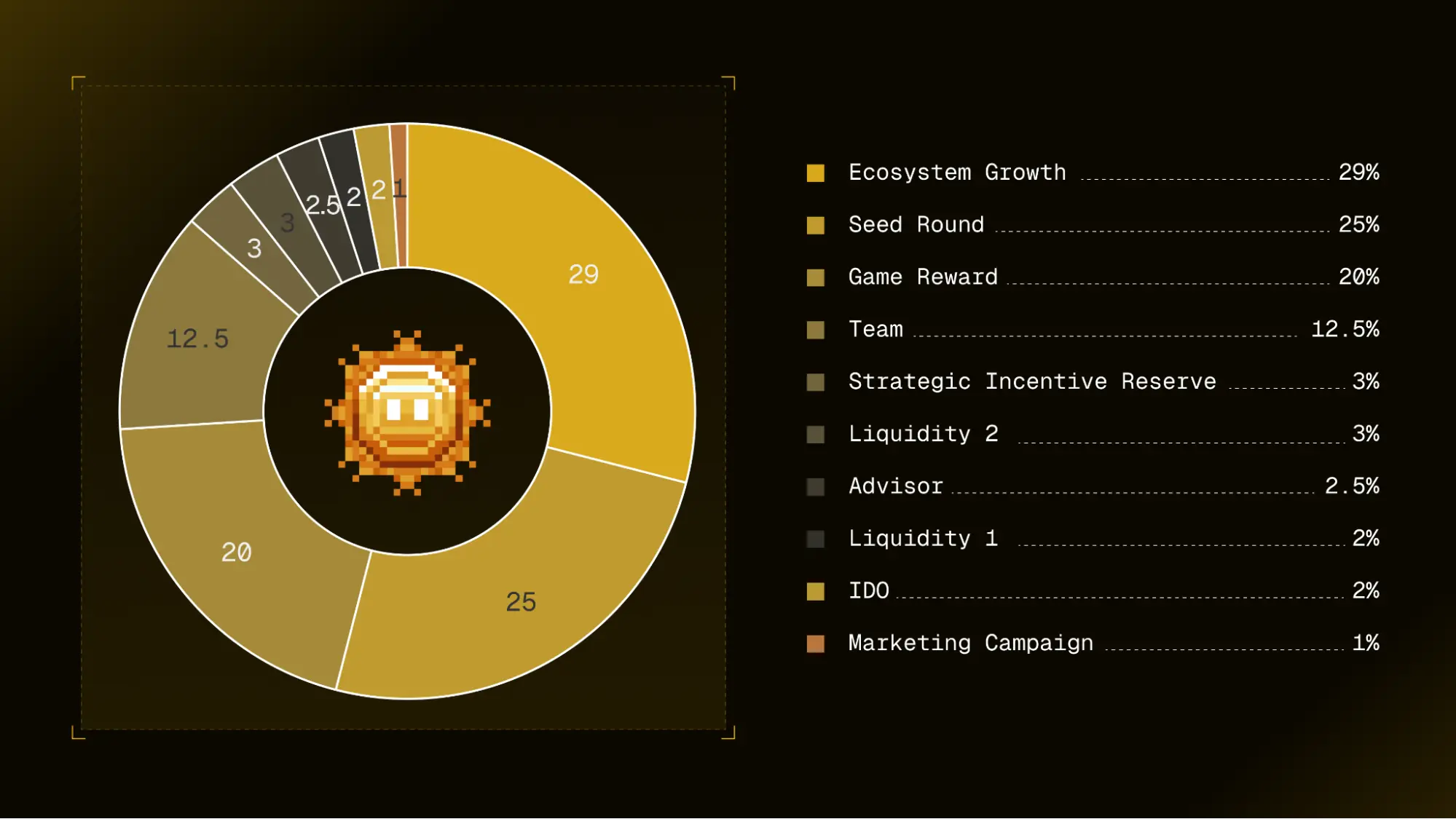
Vesting Schedules:
- 6- to 12-month cliffs for seed and team allocations
- Linear releases over 12 to 24 months following the cliffs

As of the time of writing, the $AIOT token is trading at $1.56, with a 24-hour trading volume exceeding $73 million, according to CMC. The circulating supply stands at approximately 82.5 million tokens.
Over the past week, the token has surged by nearly 150%, rising from a low of approximately $0.60 to its current levels, driven by increased trading activity and ecosystem announcements. The token is also up by 273% in the last 30 days. This price movement reflects growing interest in the protocol's DePIN model, with daily volumes reaching highs amid the rally.
Core Mechanism and Participation
OKZOO functions by deploying AIoT devices that gather hyperlocal environmental data. This data is validated decentralized on-chain to ensure accuracy and prevent manipulation. The network bridges the physical and digital worlds: sensors feed real-time information to AI algorithms, which in turn influence the behaviors and emotions of virtual pets.
Users contribute data passively through hardware, earning tokens in a circular economy that incentivizes participation, staking, and governance. The platform addresses limitations in traditional monitoring by providing precise, indoor/outdoor, and user-driven data collection.
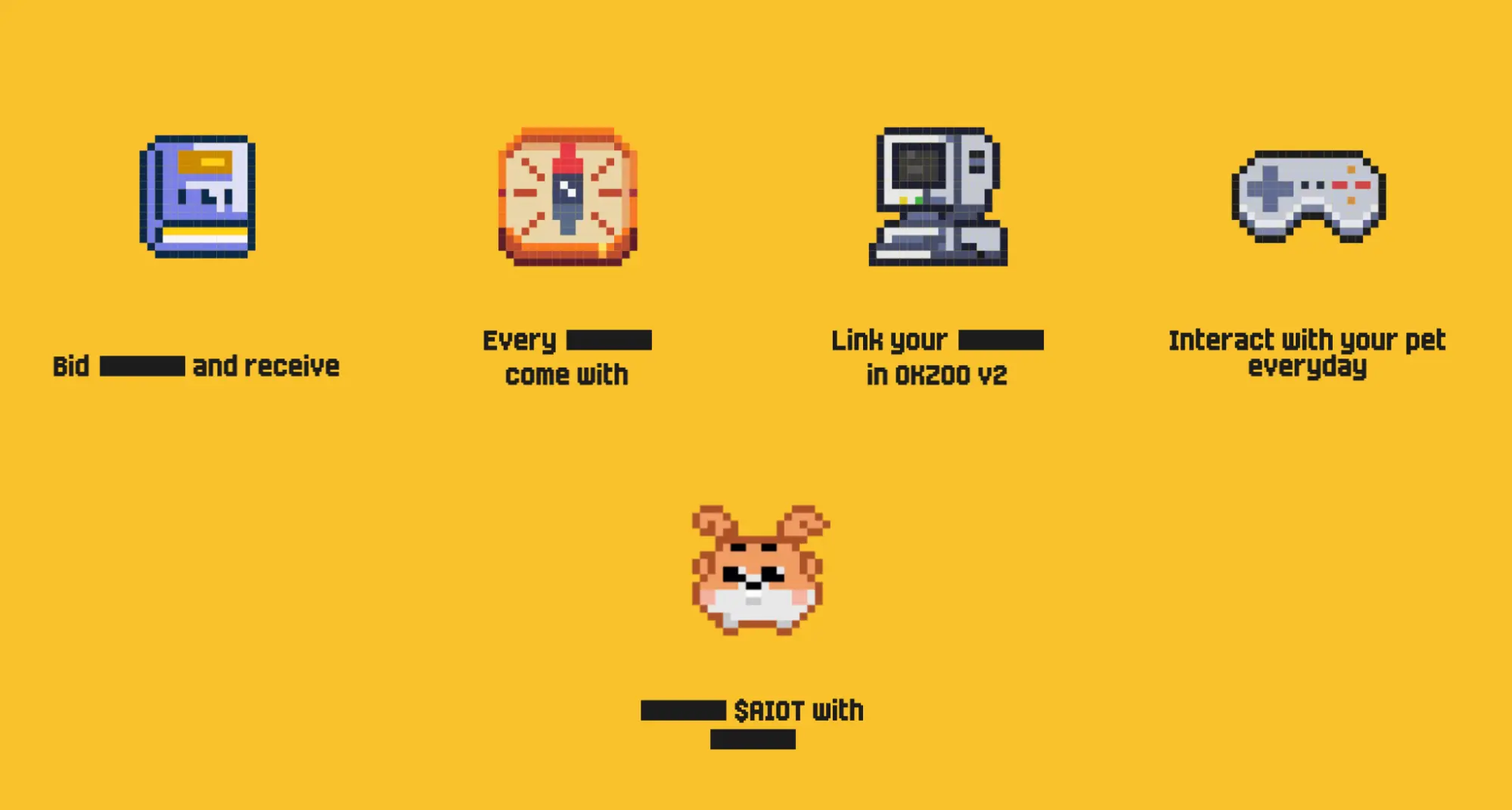
User Steps and Interaction
To participate in OKZOO:
- Acquire and use P-mini devices to collect environmental data; these act as both sensors and interactive companions.
- Nurture virtual pets in the app, where pet health and emotions respond to real-world data (e.g., poor air quality might make a pet "sad").
- Earn $AIOT tokens by contributing data, maintaining healthy environments, or staking as validators/data providers.
- Engage in governance by voting on proposals using held tokens.
- Customize and evolve pets using tokens to unlock features such as special abilities or NFT integrations.
The virtual pet app (OKZOO V2) serves as the frontend, with hardware providing backend data input. Users can also trade $AIOT on exchanges like MEXC for entry into the ecosystem.
OKZOO V2
OKZOO V2 is a digital pet environment that links virtual companions to physical AIoT devices. It utilizes adaptive personality modeling to generate personalized behaviors based on user interactions and environmental data:
AI Interactions: AI interactions in OKZOO V2 allow for real-time adaptations to user inputs and environmental data, along with emotional responses from virtual pets. This creates dynamic experiences where pets react contextually, fostering deeper engagement with users.
Gamification Elements: Gamification incorporates progressive challenges that increase in difficulty and AI non-player characters that interact within the digital world. These features add layers of competition and narrative, encouraging users to return regularly.
Seasonal Systems: Seasonal systems introduce thematic events tied to real-world or simulated seasons, rewarding users for maintaining healthy environments through their pets. This mechanic aligns virtual rewards with positive real-world behaviors, including monitoring air quality.
Pet Evolution: Pet evolution progresses through five stages, from basic forms to advanced ones, unlocking new areas, such as Verdant Haven, for exploration. Each stage requires accumulating experience points, motivating consistent care and interaction.
Care Metrics: Care metrics track aspects such as happiness, fullness, hygiene, and health, which are influenced by user activities like feeding, dancing, or other nurturing actions. These metrics directly impact pet wellbeing and evolution, providing measurable feedback on user efforts.
Weather Systems: Weather systems simulate six different conditions, such as sunny or stormy, that affect pet wellbeing and require adaptive care strategies. This adds realism and variability, linking virtual pet health to environmental simulations.
Personality Traits: Personality traits, including types like scholar or extrovert, develop over time based on user interactions and care patterns. These traits influence pet behaviors and responses, personalizing the experience for each user.
Overall, this version of OKZOO enhances data collection by integrating engaging elements that make participation more appealing and enjoyable. The combination of fun mechanics with practical environmental monitoring sustains user involvement and improves network contributions.
Roadmap and Upcoming Developments
The roadmap outlines phased development. In the second quarter, milestones included launching the P-mini o1 with holographic 8-bit companions and limited editions, as well as AI engine upgrades for nuanced personalities and memory systems.
The third quarter plans the P-mini o2 launch with OKZOO V3, incorporating enhanced personalities and NFT integration for ownership, trading, and collaborations, along with tournaments.
The fourth quarter focuses on expanding OKZOO World for shared virtual spaces and inter-pet socialization, collective learning for distributed ability development, and creator tools for custom challenges with AI-balanced integration.
Upcoming developments include Physical NFTs, or P-NFTs, set for OKZOO V3 in the third quarter. These will enable verifiable ownership and trading of pets and devices, adding collectible and competitive aspects. The P-mini o2, launching with V3, will build on the o1 model with improved features, though specifics are pending. These steps support goals like distributed learning and creator tools in the fourth quarter, potentially extending to advanced environmental applications.
Conclusion
OKZOO has shown progress in user adoption, with its ecosystem reaching over 12 million users as of May 2025, up from 6.5 million in February. The protocol has completed the Q2 roadmap milestones, including the launch of the P-mini o1 device and AI engine upgrades. It is advancing toward Q3 goals, such as the release of the P-mini o2 and NFT integrations. Token performance reflects market interest, with $AIOT experiencing a significant increase recently.
The protocol contributes to the DePIN sector by combining hardware manufacturing with on-chain data mechanisms, enabling decentralized environmental monitoring that addresses gaps in centralized systems. Its model, which incorporates token incentives and gamified elements, supports potential applications in smart cities and data-driven urban planning. However, outcomes depend on continued execution and market conditions.
Resources:
- Website: https://okzoo.app/en
- CoinMarketCap: https://coinmarketcap.com/currencies/okzoo/
- OKZOO Documentation: https://docs.okzoo.app/
- P-mini o1: https://order.okzoo.app/
Read Next...
Frequently Asked Questions
What is OKZOO?
OKZOO is a decentralized environmental data network on the BNB Chain, using AIoT devices to collect air quality, noise, and other metrics via user-deployed hardware.
How does the $AIOT token function in OKZOO?
The $AIOT token rewards data sharing, staking, and validation, with utilities including governance, pet evolution, and API access, under a total supply of 1 billion.
What are OKZOO's upcoming developments?
OKZOO plans P-NFTs for asset ownership and the P-mini o2 device in Q3, followed by virtual world expansions and creator tools in Q4.
Disclaimer
Disclaimer: The views expressed in this article do not necessarily represent the views of BSCN. The information provided in this article is for educational and entertainment purposes only and should not be construed as investment advice, or advice of any kind. BSCN assumes no responsibility for any investment decisions made based on the information provided in this article. If you believe that the article should be amended, please reach out to the BSCN team by emailing [email protected].
Author
 UC Hope
UC HopeUC holds a bachelor’s degree in Physics and has been a crypto researcher since 2020. UC was a professional writer before entering the cryptocurrency industry, but was drawn to blockchain technology by its high potential. UC has written for the likes of Cryptopolitan, as well as BSCN. He has a wide area of expertise, covering centralized and decentralized finance, as well as altcoins.
(Advertisement)
Latest News
(Advertisement)
Crypto Project & Token Reviews
Project & Token Reviews
Comprehensive reviews of crypto's most interesting projects and assets
Learn about the hottest projects & tokens


